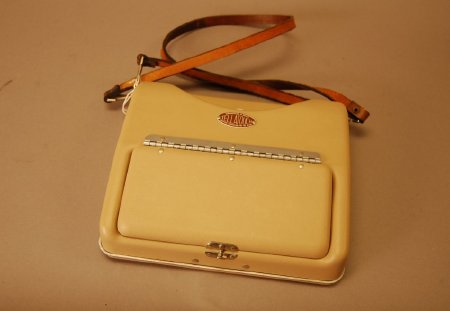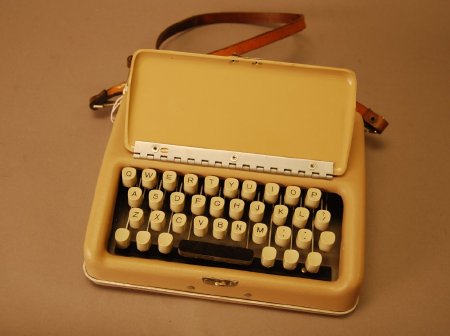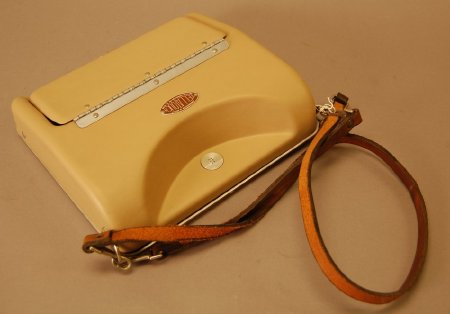Object ID:
2003.185.66
Title:
Tellatouch
Description:
Tellatouch is a device for communication with a deaf-blind person who reads braille. Similar to a small portable typewriter, Tellatouch has a 4-row keyboard. Letters of the alphabet and puncutation mark keys make up the first 3 rows. The bottom row consists of six standard braille keys. Pushing the keys raises metal pins in a single braille cell located at the top back of the machine. A deaf-blind individual can read the cell by touch as the keys are typed by another individual. The device has a hinged lid with a metal clasp that covers the keys. The exterior is beige textured plastic. A metal plate on top of machine reads: "Communication in Braille, Tellatouch, American Foundation for the Blind." The device weighs about 3 1/2 pounds. Leather straps are attached to the back of the machine. A Kentucky School for the Blind property label with no. 105657 is attached to the bottom.
Dimensions:
H-2.75 W-10 D-9 inches
Date:
ca. 1954
Made by:
American Foundation for the Blind
Place of Origin:
New York
Provenance:
Item was removed from the KSB History Room. Jackson Kleber was an electrical engineer who had worked for both RCA and Bell Telephone. Laid off as a result of the depression, he came to work for the American Foundation for the Blind in 1932 to help continue research efforts on the development of the "Talking Book." AFB launched a major effort on behalf of the deaf-blind in the mid 1940s. One of the first projects was an electrical device that would allow a typist to sit on one side, facing a standard keyboard. The machine would translate the keystrokes into a Braille symbol on a plate at the back of the machine, "where a deaf-blind person could feel them with a fingertip."
Kleber worked out the initial prototype. It was later modified by another important AFB researcher, Clifford Witcher. This early model, the Electro-braille Communicator, failed in field testing and was withdrawn in 1952. Later that year, Charles P. Tolman, a semi-retired engineer, was hired as AFB's technical research chief. Tolman solved the machine's problems by converting it from electrical to mechanical power and it was renamed the "Tellatouch" in 1954.
Kleber worked out the initial prototype. It was later modified by another important AFB researcher, Clifford Witcher. This early model, the Electro-braille Communicator, failed in field testing and was withdrawn in 1952. Later that year, Charles P. Tolman, a semi-retired engineer, was hired as AFB's technical research chief. Tolman solved the machine's problems by converting it from electrical to mechanical power and it was renamed the "Tellatouch" in 1954.
Credit Line:
Gift of the Kentucky School for the Blind, 2003.185


